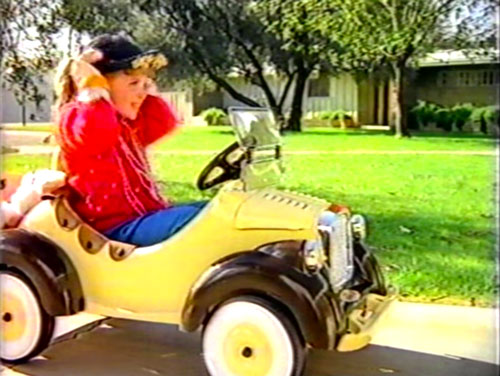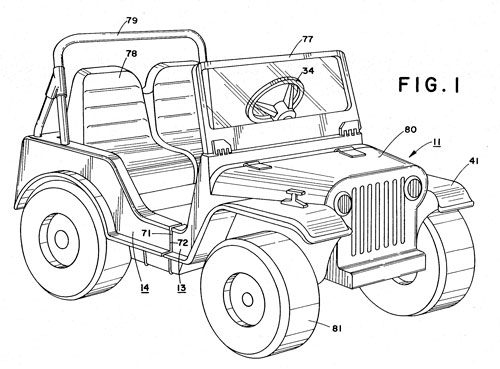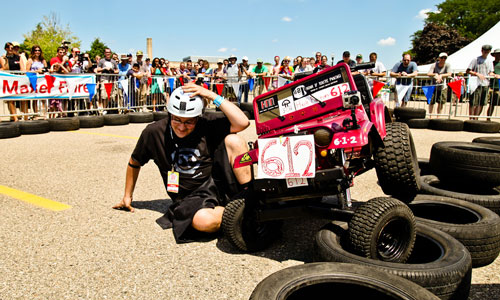Tesla For Tots
It took a while for Power Wheels to get the right branding, but the tiny motorized cars eventually took the toy aisles by storm—despite recall-worthy flaws.
Hey all, here’s a refeshed piece about an icon of holiday toys. It might be a little small to use as an adult, though. Cheers!
Sponsored By Lemonade
FYI—renters insurance covers your stuff (phone, bike, etc.) from theft wherever you go: The name might not spell it out, but renters insurance is actually ‘stuff insurance’. Ever worry about your phone getting swiped at a cafe or bar? Well, you won’t any longer—get insured with Lemonade in 90 seconds, starting at $5/month.
$254
The amount that four parents were forced to pay the family of a Maine child whose Power Wheels Jeep Wrangler was stolen, according to Mental Floss. The jeep was stolen by a trio of adolescent girls who repainted the vehicle black and removed the decals. When word surfaced that the vehicle had been stolen, the parents broke the car into pieces in an effort to hide the evidence—a cover-up that led to the fine. The best crimes are the ones that involve enabling your young children.

(YouTube screenshot)
The story of Power Wheels’ creation can be credited to an Italian company, mixed with a couple of mergers
As ideas for toys go, a miniature version of the 20th century’s greatest form of transportation, designed for kids, was obvious.
But it did not happen overnight. While Power Wheels appeared to come out in the late ’80s as a fully formed branding machine, it was actually a product formed from quite a bit of evolution. At the center of this evolution was an Italian company named Peg-Pérego. The firm, which got its start in 1949 by selling baby carriages, slowly moved into the business of selling toys built for riding.
At first, this meant car-shaped toys with wheels and pedals, but Peg-Pérego eventually had the idea to shove a gel cell battery into these wheeled machines, and suddenly, the product line was off to the races. The firm launched a subsidiary called Pines of America, which started selling these rechargeable machines in toy stores around the U.S. under brand names like Traffic Patrol and Trail Blazer.
In the early ’80s, the Italian firm sold off Pines of America to a firm called Kransco, which took Peg-Pérego’s great idea and properly branded it.
(Peg-Pérego, by the way, is still around, and is essentially Power Wheels’ biggest competitor, with the Italian company deciding to compete with its old subsidiary after it noticed the growth they were having. Its biggest claim to battery-powered fame is its miniature John Deere tractors.)
By 1985, Pines of America was selling three kinds of Power Wheels (a retro-looking “classic convertible,” an ATV-style vehicle, and a miniature monster truck) to the public.

(Google Patents)
Pines of America and Kransco put much of the work in towards patenting much of the functionality used in the vehicles, including the dynamic braking in the all-terrain vehicle, the assembly method for Power Wheels, and the design of the controls and pedals embedded in the vehicles. It wasn’t a car, but the battery powered ride on toy was sure patented like it was headed on the highway.
And like actual cars, they had their design flaws. If you’ve owned one, you know that they’ve experienced a number of recalls over the years, and that trend started really early—before they even took on the name. As the first Power Wheels even hit the market, the Consumer Product Safety Commission was recalling its predecessor due to overheating caused by a short circuit.
But those risks couldn’t stop the interest in these extremely expensive toys. In 1986, Pines introduced its first Jeep to the scene, and from there, numerous other models slowly began to appear—more than 100 in all over the years.
The vehicles were never incredibly powerful—their speeds, generally a slow putter, top out around five miles an hour due to the limited voltage of the devices (6 volts for smaller devices, 12 volts for larger ones). But on television, they looked a lot faster, and that was enough to get kids hooked.
(If you want a faster one for your kids, by the way, look to Peg-Pérego, which sells its devices at higher voltages than commonly seen on Power Wheels.)
Despite the slow speeds, their power couldn’t be ignored. Mattel purchased Kransco in 1994, a $254.6 million purchase (according to the toy giant’s 1995 10-K annual report) that made Mattel the largest American toymaker. It was largely driven by Power Wheels’ success.
Despite the fact that Kransco had the venerable Wham-O brand under its wing, Power Wheels vehicles made up as much as 80 percent of Kransco’s sales in 1994, according to the Los Angeles Times. And 80 percent of $170 million is no joke.
Considering that miniature motorized vehicles probably cost a lot more per unit than a hula hoop, the high revenue total makes sense to a degree, but it also points to the success of the brand, which soon found a home with Fisher-Price, another Mattel acquisition. It’s been there ever since.
“When a company hides problems, it means dangerous products continued to be sold and people can be hurt. If they reported, we might have prevented some of these fires and injuries.”
— Ann Brown, the chairwoman of the Consumer Product Safety Commission from 1994 to 2001, discussing the decision by the commission to fine Mattel $1.1 million—a record fine at the time for a toymaker, later outdone by Mattel itself—over the Power Wheels line of toys that caused fires or prevented the vehicles from stopping. The problem was less about the misdeed itself (they had a bunch of defects) and more about the cover-up (they knew about the problems with the cars for 14 years before doing anything). Since then, the company has doubled down on safety regarding Power Wheels, with a page on the Fisher-Price website talking about the tiny cars like you’re buying a freaking F-150.

The second life of Power Wheels is best exemplified by the muddy violence of Barbie Jeep Racing
Power Wheels is obviously still a big deal today, but the concept has been around long enough that there’s a degree of nostalgia attached to the devices.
A lot of objects that came to prominence in the ’80s—think Casio keyboards and retro video games—have gained some modern cultural currency as hacked-apart artifacts with their full colors exposed. (And yes, in case you’re wondering: Teddy Ruxpin hacking is a thing.)
Power Wheels, with its multiple recalls, tiny sizes, and branded designs, also lend themselves to such hacking, complete with a community to boot. Most commonly, Power Wheels modders will rev up the voltage on the vehicles so that they go a little faster (and freak out spouses in the process), though some might add headlights, or add radio control to the vehicles. One modder recently featured on Hackaday added a speedometer and high-intensity LEDs, among other things, to an old Peg-Pérego.
Heck, some folks even add sound systems to these things, so that babies can jam out to Lady Gaga just like everyone else.
But perhaps the true place where Power Wheels shine in the modern day is a tad bit more, uh, deconstructive. It’s a sport of sorts called Extreme Barbie Jeep Racing, a variation on offroading that involves taking battery-powered vehicles and racing them down a hill in dramatic fashion, taking all the bumps that come with. You might start with the mini-Hummer, but you likely won’t end with it in one piece.
The twice-yearly Rednecks With Paychecks offroad event in Texas has its own entertaining twist on this phenomenon called the Redneck Downhill, which turns this messy sport into something of Olympic proportions, complete with cash prizes.
Wait until the Consumer Product Safety Commission hears about this.
All this modding and destruction is great, obviously, and you have to wonder whether Mattel is taking some inspiration from it in building out newer Power Wheels models.
To put it simply, they are—and they’re not alone. Not too long ago, Radio Flyer made some waves when they launched a miniature version of the Tesla Model S—another, slightly more powerful vehicle that also happens to rely on battery power. The device is totally decked out, and comes with working headlights and a built-in audio system. You can get it in four different coats of paint and with two kinds of wheels. And—of course!—it runs on Tesla-friendly lithium-ion, versus the more common gel-cell batteries used in vehicles for kids. Like its parent car, it’s incredibly expensive. It’s to Power Wheels what a Tesla is to GM.
(No CyberTruck yet, though. I checked.)
But not to be outdone, Power Wheels is not one to shy away from clever branding: The company sells a miniature Ford Mustang, and earlier this month teamed with Walmart Canada to start selling a Jurassic Park-branded Jeep.
But current owner Mattel is even stretching things in brand new directions entirely, recently holding a demo at the company’s headquarters that showed Power Wheels devices modded for children with disabilities—something a third-party vendor, GoBabyGo!, specializes in.
“For her to have the ability to have something she can do with other kids is really important to her,” Kalle Faruki, the parent of a 4-year-old with cerebral palsy, told The Daily Breeze of the effort. “This is a dream come true for her.”
Perhaps it’s absurd to think that decked-out toy cars with power lock brakes and MP3 player hookups are a thing. But on the other hand, today’s kids are all going to be riding in self-driving cars when they grow up, so this may be the only experience they get behind the wheel.
Might as well emulate the experience as best as possible.
--
Find this one a fascinating read? Share it with a pal! And thanks to Lemonade for sponsoring.
:format(jpeg)/2017/06/tedium120116.gif)
/2017/06/tedium120116.gif)


/uploads/ernie_crop.jpg)